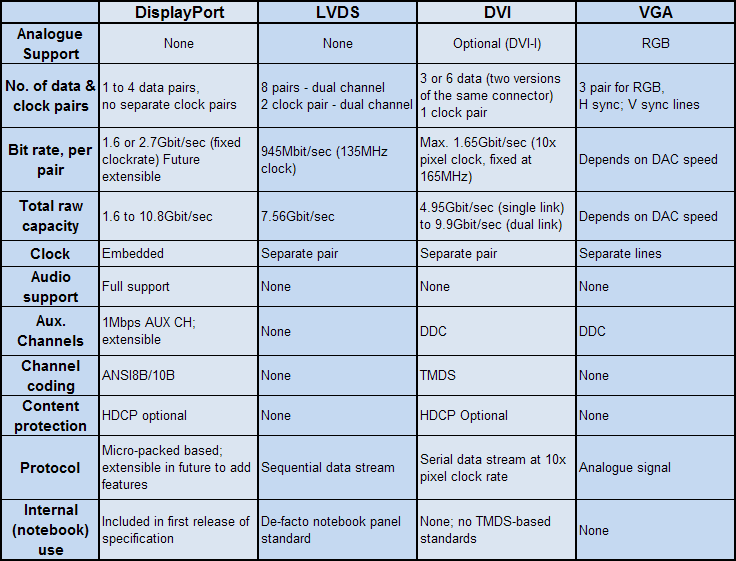
DisplayPort specifications:
According to VESA, DisplayPort is an extensible and a scalable digital display interface. As we briefly mentioned on the previous page, the interface can not only carry video, but there are also optional audio and content protection capabilities which will depend on the manufacturer’s implementation.The new interface is designed to replace both existing internal ‘chip-to-chip’ and external ‘box-to-box’ display interfaces with a single standard, but the promoter group says that it’ll still co-exist with HDMI. The reason for this is that they’re aimed at two different audiences – HDMI is aimed at box-to-box consumer electronics devices, while DisplayPort is aimed more at the PC market.
Unlike HDMI, VESA says that DisplayPort is royalty-free which means that we should see lower-priced displays, but whether this ends up being a reality remains to be seen. We are unable to confirm it until products supporting the new interface arrive on the market sometime in the first half of next year.
What's interesting though is that the DisplayPort promoters at IDF decided not to mention that some elements of the technology are licensed on RAND (reasonable and non-discriminatory) terms. This means that, at some point, IP holders could reasonably charge a royalty fee for the use of their technology in the new display standard. To me, that seems unlikely because if DisplayPort is going to succeed, it needs as few barriers as possible on its road to market adoption.

DisplayPort's specifications, at a glance.
Additionally, because DisplayPort will help to consolidate both internal and external display interfaces, it will enable the introduction of direct drive displays. This will result in much thinner and sleeker designs, as there is no need for any electronics (such as a TMDS) inside the display – another area where costs can be reduced and the savings are hopefully passed onto the consumer.
Despite all of this though, it’s worth mentioning that if display manufacturers (and graphics card manufacturers) implement the optional content protection, there will be a license fee associated with that. However, considering this is already starting to become a checkbox feature on today’s displays, graphics cards and motherboards with integrated graphics, it shouldn’t be much of an issue.
Compared to DVI, the maximum resolution hasn’t been increased a great deal (2560x1600 8bpc at 60Hz to 2560x2048 8bpc at 60Hz) with version 1.1 of the DisplayPort specification, but there is support for 10bpc colour at 2560x1600. This is something that even dual-link DVI doesn’t have the bandwidth to manage. Additionally, there is support for 12bpc YCbCr444 at 1080p/96Hz and 12bpc YCbCr422 at 1080p/120Hz with four lanes.
1680x1050, the resolution that is driving widescreen monitors into affordable price ranges, is supported over a single lane in the main link at 60Hz providing you’re sticking with just 6bpc colour. That’s the current component bit depth on pretty much all value-orientated widescreen displays, so it’s not going to change anything on that front.
Moving into the future, VESA says that it plans to upgrade the DisplayPort specifications to generation two in 2008-2009 in order to support higher resolutions like 3840x2400 at 60Hz with 8bpc RGB. There’s also the chance that this is when the auxiliary channel’s bandwidth will be given a boost too.
One thing that’s probably on your mind though is... what about support for my current PC? Fear not, we have the answers over the page.

MSI MPG Velox 100R Chassis Review
October 14 2021 | 15:04










Want to comment? Please log in.